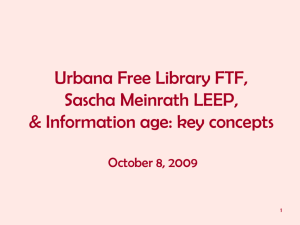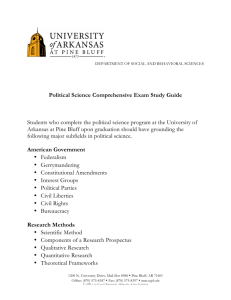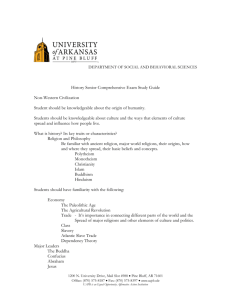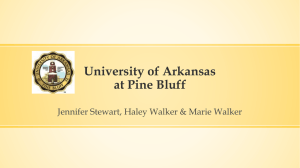class 6 CU WIN and informatics early ideas oct 1
advertisement
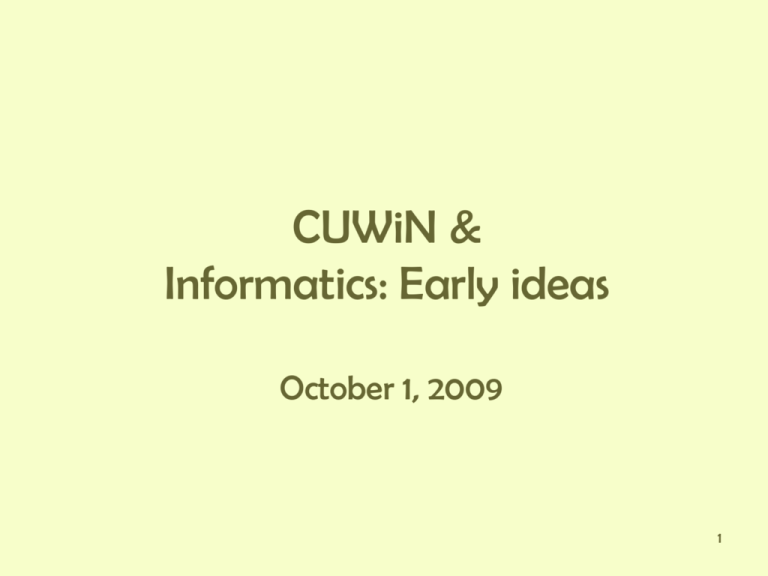
CUWiN & Informatics: Early ideas October 1, 2009 1 1. What is Community Informatics • CI: the study or practice regarding the continuity of local, historical communities meeting the transformation of information technologies • Libraries by reinventing themselves (I&R, job centers, OPACs) invented community networks (made of siliconplus-carbon) • From social informatics comes three key ideas: network society, hacker ethic, and digital divide …the LOCAL community is the central focus here 2 2. Community: ‘Race’, place and history 1. Science says, One race, the human race. Our species has always migrated, our differences are within group not between group. No one trait is found across a group. 2. Racism is real … What to do? Stay educated (on past, present, future) … Practice diversity in curriculum, profession, library 3. Class: an emergent phenomenon, as well as a categorical or positional reality, thanks to techno-economic changes 4. Root Shock: Severing people’s connections to places. “The traumatic stress reaction to destruction of one’s emotional ecosystem.” Mass upheavals have ripple effect. Solution: Acknowledge. Create healing places. Displacement the 21st C problem. 3 5. ‘Damned by ourselves, saved by community.’ 3. Dig Div, Community as network 1. Dig Div: a fxn of the information revolution. Persistent, multidimensional & changing. CI solutions mean a) communities not individuals b) seeking sustainability 2. Society ≠ Individuals … Society = Ties ! 3. Wellman/Leighton: Urbanization brings… • Community found/strong nhood networks? • Community lost/no networks? • Community liberated/metropolitan networks? • [Q: where do space and time go in SN theory?] 4. Coleman: Closed networks build social capital • So do open networks! e.g. Murchison Center 4 3a. Network models groups as nodes strong & weak ties… 5 dense and sparse networks 4. UC2B • • UC2B: 36 million in stimulus/other funds. 2 cities + univ. Fiber laid across cities, 100 Mbps to 137 critical anchor institutions, 5 Mbps to 2500+ homes in 12 lowbroadband census tracts. Above ground, support for broadband adoption. UC2B Above Ground, 3+ years, guided by GSLIS: 1. 45 + 1 public computing centers boosted or established 2. Mad Lab in N Champaign (Music Access Digitization), HQ for community helpdesk, 14 outreach/support staff 3. 17 cybernavigators serving 46 ctrs + 12 sectors serving low income people (health, ed, libs, homeless, seniors, women, disabled, safety, churches, comm ctrs, media/culture) 4. Three course sequence for 50 UI/Parkland/high school students, public video • • • Broadband 101 spring: what’s it all about Broadband 102 summer: paid broadband internships Broadband 103 fall: community-serving bband entrepreneurship, $50K in awards 5. UC2B’s community helpdesk 6. Community advisory committee, research advisory committee, PCCNet 7. Community first, technology second (CI approach) • 6 Similarly nationwide 2010-2012; nat’l bband plan by Feb 2010; broadband.gov Link to entire UC2B application on City of Champaign site: http://tinyurl.com/completeUC2B 4a. Community and disaster: recap to come 7 5. Search for bband data, and virtual community • BTOP grant specs released within weeks of due date … had to prove “underserved,” but how? … ATLAS stepped forward, led community survey … 40+ helped … 4 day campaign for numbers proved 12 census block groups eligible … will AT&T challenge? Find out next month… • From the bbs: The curse of grants and the challenge of inequality and difference • WELL: report from the info rev: virtual comm is possible, personal, gotta feel it – Virtual community as family & friend support network stands on and builds FTF • Wikipedia: social norms and technical design enable virtual community growth from 200 to 200,000 people … to … build an encyclopedia!?! – A culture e.g. simple rules for people like “Be Bold,” “NPOV” “Nice to newbies” “sofixit” – A technology e.g. software features like talk page … history … translation – What should people know about Wikipedia? – What can we learn for real-world communities? [commons based peer production, crowdsourcing] • PS: comm vs .com (Spaniards walk & WELLites share vs SN sites as corporations) 8 5. Search for bband data, and virtual community • A campaign: campus mobilized, structured reachout to community, 40 volunteers Navigating the complexities of the grant competition Found higher rate of broadband take-up 12 block groups eligible community campus / corporations (telecoms) • From the bbs: The curse of grants and the challenge of inequality and difference • WELL: report from the info rev: virtual comm is possible, personal, gotta feel it – Virtual community as family & friend support network stands on and builds FTF • Wikipedia: social norms and technical design enable virtual community growth from 200 to 200,000 people … to … build an encyclopedia!?! – – – – A culture e.g. simple rules for people like “Be Bold,” “NPOV” “Nice to newbies” “sofixit” A technology e.g. software features like talk page … history … translation What should people know about Wikipedia? [commons based peer production, What can we learn for real-world communities? crowdsourcing] • PS: comm vs .com (Spaniards walk & WELLites share vs SN sites as corporations) 9 Agenda • ‘judy olson time managenment.ppt’ online • Working the class/Making the class work for you – Writing? Now … theory, ideas, discussion – The curse of grants – The challenge of community organization / turtle metaphor • Computer Learning Month / how does it look? • Informatics: Early ideas – Bush – Kling – Mitchell 10
